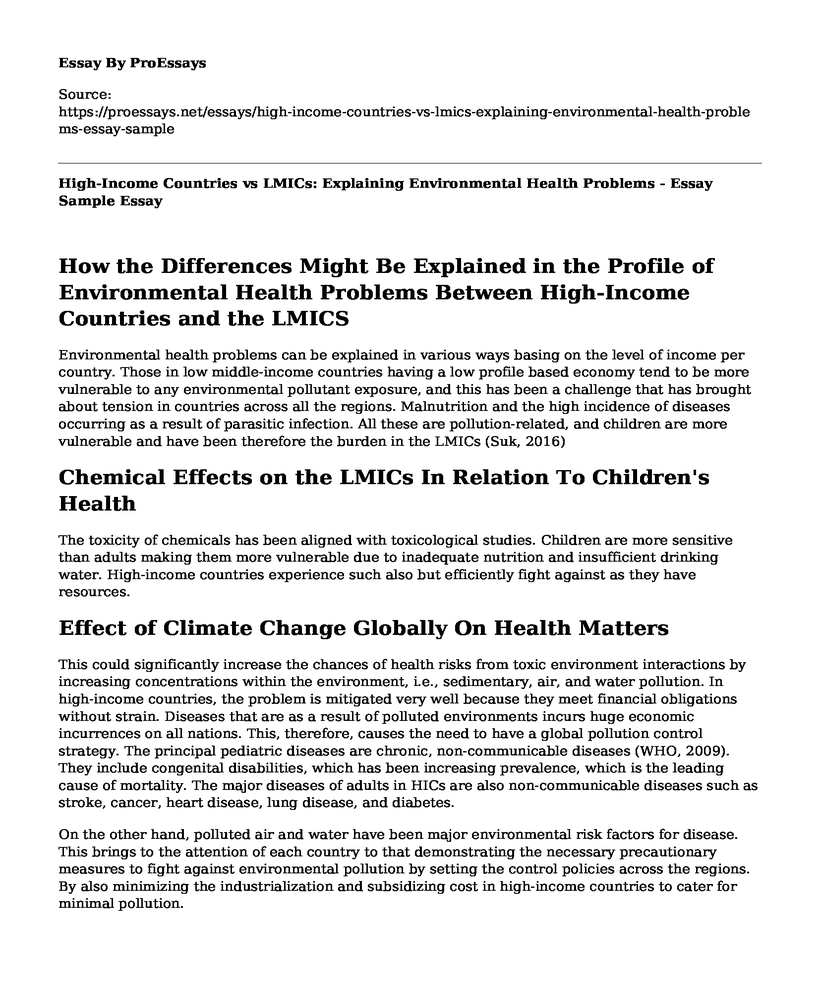How the Differences Might Be Explained in the Profile of Environmental Health Problems Between High-Income Countries and the LMICS
Environmental health problems can be explained in various ways basing on the level of income per country. Those in low middle-income countries having a low profile based economy tend to be more vulnerable to any environmental pollutant exposure, and this has been a challenge that has brought about tension in countries across all the regions. Malnutrition and the high incidence of diseases occurring as a result of parasitic infection. All these are pollution-related, and children are more vulnerable and have been therefore the burden in the LMICs (Suk, 2016)
Chemical Effects on the LMICs In Relation To Children's Health
The toxicity of chemicals has been aligned with toxicological studies. Children are more sensitive than adults making them more vulnerable due to inadequate nutrition and insufficient drinking water. High-income countries experience such also but efficiently fight against as they have resources.
Effect of Climate Change Globally On Health Matters
This could significantly increase the chances of health risks from toxic environment interactions by increasing concentrations within the environment, i.e., sedimentary, air, and water pollution. In high-income countries, the problem is mitigated very well because they meet financial obligations without strain. Diseases that are as a result of polluted environments incurs huge economic incurrences on all nations. This, therefore, causes the need to have a global pollution control strategy. The principal pediatric diseases are chronic, non-communicable diseases (WHO, 2009). They include congenital disabilities, which has been increasing prevalence, which is the leading cause of mortality. The major diseases of adults in HICs are also non-communicable diseases such as stroke, cancer, heart disease, lung disease, and diabetes.
On the other hand, polluted air and water have been major environmental risk factors for disease. This brings to the attention of each country to that demonstrating the necessary precautionary measures to fight against environmental pollution by setting the control policies across the regions. By also minimizing the industrialization and subsidizing cost in high-income countries to cater for minimal pollution.
References
WHO. 2014. 7 million premature deaths annually linked to air pollution. WHO Media Centre [news release], 25 March 2014. Geneva, Switzerland:World Health Organization. Available: http:// www.who.int/mediacentre/news/releases/2014/air-pollution/en/.
Suk, W. A., Ahanchian, H., Asante, K. A., Carpenter, D. O., Diaz-Barriga, F., Ha, E. H., ... & Sly, L. (2016). Environmental pollution: an under-recognized threat to children's health, especially in low-and middle-income countries. Environmental health perspectives, 124(3), A41-A45. https://ehp.niehs.nih.gov/doi/full/10.1289/ehp.1510517
Newell, K., Kartsonaki, C., Lam, K. B. H., & Kurmi, O. (2018). Cardiorespiratory health effects of gaseous ambient air pollution exposure in low and middle income countries: a systematic review and meta-analysis. Environmental Health, 17(1), 41. https://ehjournal.biomedcentral.com/articles/10.1186/s12940-018-0380-3
Cite this page
High-Income Countries vs LMICs: Explaining Environmental Health Problems - Essay Sample. (2023, May 19). Retrieved from https://proessays.net/essays/high-income-countries-vs-lmics-explaining-environmental-health-problems-essay-sample
If you are the original author of this essay and no longer wish to have it published on the ProEssays website, please click below to request its removal:
- The Webinar the Road to Elder Care Paper Example
- Paper Example on Entrusting My Teeth to Doctor: Trust & Understanding
- Academic Dishonesty: Impact on Nursing Enrollment - Essay Sample
- Paper Example on Analysis of Eco-Fone: Problem Solving with Data and Info
- Nurse-Patient Affair: The 5-Phase Nursing Care Process - Essay Sample
- Brain Tumors: Cancerous, Noncancerous, Malignant, Benign - Essay Sample
- Sensitive Quality Indicators - Essay Sample







